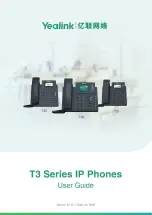
9 Mobile Least-Cost Routing (MLCR)
9
Mobile Least-Cost Routing (MLCR)
The following explains how to actively use the features
Callback
,
Call through
,
Call
Reverse
, and
SIM Switch
.
About MLCR
It is possible to configure number patterns (first couple of digits of a phone
number) which will trigger an automatic least-cost routing.
These ’rout-
ing rules’ can be deployed to the AMC from the Aastra administration por-
tal by the Administrator. The Administrator can configure several different
MLCR lists in the Portal to customize the MLCR rules for each user if nec-
essary.However, a different routing feature can be selected manually by the
user even if these routing rules are present, refer to
8.5
.
9.1
(HTTPS) Callback
Use Callback to reduce costs of outbound calls made via the AMC. In a Callback call
the call to both the A- and B-party are setup from the PBX. How to start a
Callback
is
explained in
8.5
on page
24
. If your company makes global use of the MLCR, dialing
certain phone numbers might trigger a
Callback
automatically! Rules for automatic
routing can be made and deployed to the AMCs using the AMCC.
Note:
The HTTPS Callback request goes through a data connection that might not be
available or fail. In the case of failure, the AMC will automatically fall back to a Call-
through call. The call is still placed through the PBX, however, you do not have the cost
benefits anymore.
General setup and functionality are documented on page
46
.
9.2
(HTTPS) Call Reverse
If
Call Reverse
is enabled, inbound calls (to the users mobile number) can be trans-
formed into outgoing calls to make use of favorable tariffs for calls from the cellular
network. This happens automatically, so from the user perspective a
Call Reverse
completely resembles an inbound call: you can decline or accept it.
amc-3.0_symbian_ug_en_2012-09
30
















































